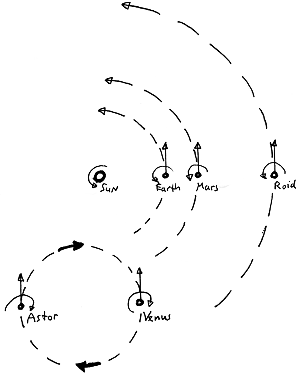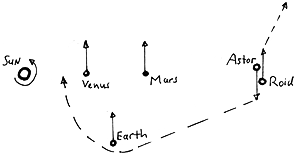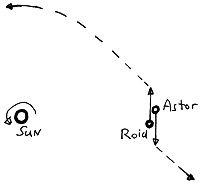 Figure 7-3-I
Astor and Venus entering the Solar System. The clash may have caused the asteroid belt, Pluto and Charon and Mercury (Mercury would be the heavy inner core of Astor or Roid). The clash then may have been as drawn in Fig. 7-3-II. After the clash Astor ought to have passed Venus, the Earth or Mars quite close in order to get its orbit between Venus' orbit and the Sun or perhaps it is more likely that Astor has left the Solar System (see Fig. 7-3-III) and that Roid has become Mercury (also because Mercury does not rotate retrograde).
 Figure 7-3-II
A clash may have caused the asteroid belt.  Figure 7-3-III
A way Roid may have become Mercury. Such a clash may explain: the existence of the asteroid belt, retrograde rotation of Venus and Pluto, the strong eccentricities of Mercury and Pluto, the strong inclination of Mercury and Pluto, the fact that Mercury is very massive for such a small planet (part of the less massive mantle has been ripped of by the clash), the high percentage of metals of Mercury, the long sidereal rotation period of Venus (Venus' rotation is slowed down quicker because of its retrograde rotation), the almost synchronous rotation by Mercury (because of the clash; a sidereal rotation period of 58.7 days compared to a sidereal period of 88 days), the slow sidereal rotation period of Pluto, the little mass of Pluto, the obliquity of Mercury (0.0 degrees) and the clash may have brought our Moon to existence, as well as moons and debris circling around the Jovian planets and the two pieces of debris circling Mars.
[May 2003: Shepard and Jewitt recently have discovered many small new moons orbiting Jupiter retrogate69. Explaining such retrogate velocities is a severe problem for conventional astronomy. The (presumed) clash between Astor and Roid may solve this problem. End May 2003] [April 12 2006: According to current big bang models of planetary formation, Mercury has too much mass. A new explanation proposes that Mercury was created from a much larger parent planet that collided with a giant asteroid 4.5 billion years ago. Astronomers from the University of Bern ran various scenarios modeling early versions of Mercury412. End April 12 2006] Perhaps one of the two planets that clashed, or both, had a lot of water; that would explain the amounts of water on Pluto and the moons of Jupiter. If Pluto is a remain of the outer part of planet Astor or Roid then that would explain the low density of Pluto.
If Pluto and Charon are remains of the clash then it is logic that they are relatively close to each other. Only some satellites of Mars and Jupiter orbit their parent planets faster than the parent planets rotate. This may be because Mars and Jupiter are the two planets that would have been most close to the point of the clash (and further away from the Sun), and so those planets had more chance meeting a piece of high speed debris. The asteroids in the asteroid belt have S-type character (closer to Mars) or a C-type character8 (closer to Jupiter); the two types of asteroids may be due to two planets clashing.
[January 2005: Also big bang astronomers speculate about the evolution of Pluto and Charon with a giant impact in the past275. End January 2005]
Iron meteorites have densities ranging from 7500 to 8000 kg/m3. The solid inner core of the Earth has densities around 13,000 kg/m3. Iron meteorites thus may originate from dark matter that clashed, maybe from Astor clashing with Roid.
[September 10 2005: When Deep Impact smashed into comet Tempel 1 on July 4, 2005, it released ingredients. These ingredients include many standard comet components, such as silicates, or sand. But there were also surprise ingredients, such as clay and chemicals in seashells called carbonates. These compounds were unexpected because they are thought to require liquid water to form359.
More impacts by the Astor-Roid clash
The clash may also explain the strong meteorite bombardment that happened billions of years ago in our Solar System and caused so many craters on, for example, our Moon and Mercury.
Planets closer to the Sun, Venus and the Earth, would have collected less debris: those planets have less mass and have to compete with the Sun. Mars has two pieces of debris, which is probably due to Mars having more chances to collect debris being so close to the asteroid belt. The debris that circles around the Jovian planets had more chance to be picked up by those planets, for the planets have more mass and the debris that was falling away from the Sun was slowed down by the gravity of the Sun (where the debris falling towards the Sun was speeded up). Our Moon may originate from the mantle of Mercury, especially when Mercury has passed the Earth at a close distance as shown in Fig 7-3-II.
Mercury has three times the number of craters 10 km or larger in diameter than the Moon has8. If Mercury and the Moon originated in the Astor-Roid-clash then it may be logic that Mercury took more and bigger pieces debris with it (because the mass of Mercury is 5 times the mass of the Moon), which would explain the higher number of large craters on Mercury compared to the Moon (and the Earth competed with the Moon, so much debris attached to the Moon may have gone to the Earth). Perhaps there has been a clash between planets at 50,000 AU as well, resulting in the Oort cloud. Also the Kuiper belt beyond the orbit of Neptune may be a remnant of clashing planets or clashing debris (that came from the Astor-Roid-clash).[September 10 2005: Three objects nearly Pluto-sized or larger were recently found in the Kuiper belt. All three are in elliptical orbits tilted out of the plane of the solar system. Astronomers think that these orbital characteristics may mean that they were all formed closer to the sun362. End September 10 2005] (Perhaps the Oort cloud is also due to the clash between Astor and Roid.)
[June 2004: The Kuiper belt too may have come to existence because a group of dark matter objects (which may have originated from a clash between two larger dark matter objects somewhere in interstellar space) came out of interstellar space and started orbiting the Sun. Right now the Kuiper belt is a mystery for big bang astronomers160. End June 2004] [January 2005: Also big bang astronomers speculate about the evolution of the Kuiper belt objects with a giant impact in the past275. End January 2005] [September 5 2005: A big bang researcher from the University of Toronto has found unexpectedly young material in meteorites, challenging big bang theories about early events in the formation of the Solar System. A paper published in Nature reports that key minerals called chondrules have been found in meteorites that formed much later than the initial nebula that, according to big bang astronomy, collapsed to form our Solar System. Instead, these chondrules were probably created when two newly forming planets smashed together, the researcher reports. The researcher thinks the chondrules were formed by a giant plume of vapour produced when two planetary embryos, somewhere between moon-size and Mars-size, collided. Within big bang astronomy the evolution of the solar system has traditionally been seen as a linear process, through which gases around the early sun gradually cooled to form small particles that eventually clumped into asteroids and planets. Now there is evidence of chondrules forming at two very distinct times, and evidence that embryo planets already existed when chondrules were still forming. “It moves our understanding from order to disorder,” the researcher admits. “But I am sure that as new data is collected, a new order will emerge.”352. End September 5 2005] Also: Venus may be a planet that did not come in as a binary system, but sole and hardly rotating (retrograde). This may explain Venus' very large sidereal rotation period, the fact that Venus rotates retrograde and Venus' low eccentricity.
(If a sole planet coming into a solar system starts orbiting with a relatively low eccentricity compared to a binary system then this would explain why the Earth, Jupiter and Neptune have lower eccentricities than their partners: a sole planet coming into the Solar System may start rotating with a relatively low eccentricity and in a binary system the heavier partner acts more as a sole planet.
Perhaps the momentum in a binary system causes higher eccentricities. This would explain the relatively high eccentricities of Jupiter and Saturn, which have relatively short sidereal rotation periods and thus had relatively fast orbiting velocities (when entering the Solar System) and hence a relatively big momentum causing eccentricity.) [June 2004: A cloud of gas and dust and debris falling on a dark matter object, thus causing star formation as discussed in 7-1, may also bring proto-planetary discs which have been observed162,174. Therefore solar system formation too may be caused by the formation of proto-planetary discs next to sole dark matter objects flying into the solar system (7-1).
[September 23 2005: Using NASA's Spitzer Space Telescope, a team of astronomers led by the University of Rochester has detected gaps ringing the dusty disks around two stars. Spitzer's Infrared Spectrograph instrument clearly showed that an area of dust surrounding certain stars was missing, strongly suggesting the presence of a planet around each. The only viable big bang explanation for the absence of gas is that a planet, most likely a gas giant like our Jupiter, is orbiting the star and gravitationally “sweeping out” the gas within that distance of the star, the researchers say. These observations represent a challenge to all existing big bang theories of giant-planet formation, especially those of the “core-accretion” models in which such planets are build up by accretion of smaller bodies368.
[November 2004: Recently big bang astronomers looked for dusty discs around 266 nearby stars of similar size, about two to three times the mass of the sun, and various “ages” (that is, what big bang astronomers call ages, 4-4). Seventy-one of those stars were found to harbor discs. Instead of seeing the discs disappear in “older” stars, the astronomers observed the opposite in some cases. The team found some “young” stars missing discs and some “old” stars with massive discs257.
[July 21 2005: Big bang astronomy states that dust disks around newborn stars disappear in a few million years; the disks ought to vanish because the material has collected into full-sized planets. Big bang astronomers have discovered a dust disk that shows no evidence of planet formation. The astronomers estimate the newfound disk to be about 25 million years old. For big bang astronomers the discovery raises the question of why this disk has not formed planets despite its advanced age341.
[March 31 2005: Red dwarfs are smaller and cooler than our own Sun, but they account for 70% of the stars in our galaxy. Astronomers have wondered why there are so many red dwarfs, but they never seem to have protoplanetary discs of dust surrounding them, indicating the formation of new planets. These stars are too small to remove dust the way larger stars do it307.
|